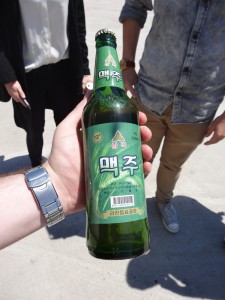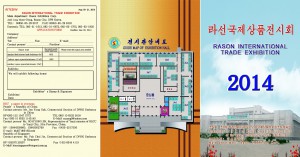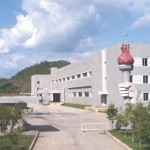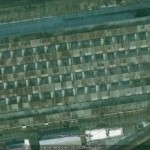Choson Exchange has published their 2015 annual report. Read it here to learn about the interesting work they are doing in the DPRK.
Archive for the ‘Choson Exchange’ Category
Choson Exchange 2015 report
Tuesday, April 19th, 2016Samgak Beer
Wednesday, June 24th, 2015Choson Exchange has let the world know about a new North Korean beer: 삼각맥주
The name means “triangle” beer, or more accurately “river delta” beer.
It is manufactured at the Rajin Drink Factory (라진음료공장). I do not know where this factory is located, so please let me know if you happen to learn.
4th Rason International Trade Fair (UPDATED)
Wednesday, August 20th, 2014UPDATE 4 (2014-8-22): KCNA reports the following:
DPRK Products Win Popularity at Int’l Trade Exhibition
Pyongyang, August 22 (KCNA) — Products from the DPRK won popularity at the 4th Rason International Trade Exhibition.
Those products, presented by 20 companies, include fur goods, fine art works, handicrafts, different kinds of drinks made with natural vegetables and garments.
The Rajin Drink Factory displayed Paekhwa Liquor, brewed with 100 species of flowers, which is very good for health as it contains rich amino acids and vitamins.
The Rason Samdaesong J.V. Company exhibited various trucks.
Pak Yong Gun, president of the company, told KCNA:
My company manufactures various types of trucks. It also produces containers and others by itself.
We will boost production to the maximum by introducing streamlined process.Among the popular products were also tens of kinds of health foods, made of edible herbs, wild fruits and honey.
UPDATE 3 (2014-8-21): KCNA reports on investment forum at the trade fair:
Investment Forum Held in Rason of DPRK
Pyongyang, August 21 (KCNA) — A forum on investment in the Rason economic and trade zone of the DPRK took place on the spot on Aug. 19.
It draws companies from Russia, China, Italy, Thailand and other countries taking part in the 4th Rason International Trade Exhibition.
The participants in the forum viewed a video on the natural and geographical conditions of the zone and its development situation and long-term plan.
They were also briefed on the legal guarantee for the zone development, business establishment and management regulations for foreign investors, the situation of foreign companies which have already invested in the zone, the vitalization of tourism, etc.
Then, speeches were made by businessmen of different companies who are willing to invest in the zone.
UPDATE 2 (2014-8-20): KCNA reports that the fair is going well (surprise!):
4th Rason International Trade Exhibition Draws Attention of Businessmen
Pyongyang, August 20 (KCNA) — The 4th Rason International Trade Exhibition is going on in Rason City, the economic and trade zone in the northeastern part of the DPRK.
In this regard, KCNA had an interview with Kim Hyon Chol, deputy director of the Department of Economic Cooperation of the Rason City People’s Committee.
Kim said:
More than 100 local and foreign companies are taking part in the exhibition. The annual exhibition is intent on achieving the economic development common to the DPRK and other countries.
Through the exhibition, businessmen have been acquainted themselves with the development of the Special Economic Zone (SEZ). And they are having discussions on the possibilities of efficient trade while making import and export contracts.
The Rason City has been developed into an international region for relay transport, trade and investment, financial transactions and tourism.
The president of the Rason Noviymir Co. under the Russia-Far-east Investment Co. Ltd, told KCNA:
It is the third time for my company to take part in the exhibition.
I have felt that progress has been made in every exhibition. And it has been well organized.
I hope that the exhibition will boost the cooperation between countries and regions. Especially, I want Russia and the DPRK to further develop the friendly cooperation in the fields of economy and trade.
My company is making investments in producing foodstuffs like sea foods and planning to expand their production and volume of export. I want many more Russians to participate in the exhibition.
Willam Zhao, director of the UNAFORTE Ltd of Italy, said:
It is the first time for my company to attend the exhibition and it feels good.
The DPRK people’s living standard and rate of consumption are high as evidenced by the fact that new goods are popular among them.
I was going to make an investment in the zone from a long ago and have invested in commercial buildings in the city. I hope that the economic trade zone would rapidly develop.
Michael Basset also tweeted a photo of HBOil participating in the fair.
UPDATE 1 (2014-8-18): The trade fair has opened. According to KCNA:
4th Rason International Trade Exhibition Opens
Rason, August 18 (KCNA) — The 4th Rason International Trade Exhibition opened with a due ceremony in Rason City Monday.
The participants in the opening ceremony placed a floral basket before the portraits of smiling President Kim Il Sung and leader Kim Jong Il displayed in the Rason Exhibition Hall and paid tribute to them.
Attending the ceremony were Jo Jong Ho, chairman of the Rason City People’s Committee who is also chairman of the organizing committee of the exhibition, officials concerned, people in the city, and delegates of different countries, those who displayed products in the exhibition and foreign businessmen active in the Rason economic and trade zone.
An opening address was made at the ceremony to be followed by congratulatory speeches.
Speakers noted that the DPRK is dynamically pushing ahead with economic construction and has already laid an institutional and legal groundwork for developing and revitalizing the zone.
They said that the zone is providing economic bodies and companies of various countries and the region with a favorable environment for conducting transit trade, processing trade and tourism in line with their will and wishes. They noted that the exhibition would offer a good opportunity for promoting the friendship and solidarity among countries and further developing wide-ranging and multi-faceted economy and trade.
At the end of the ceremony, the participants looked round electric and electronic goods, light industrial products, foodstuff, daily necessities, medicines, vehicles, etc. displayed by at least 100 companies from the DPRK, China, Russia, Italy, Thailand and other countries.
KCTV footage of the opening can be seen here:
ORIGINAL POST (2014-6-8): Choson Exchange has posted the marketing flyer for the 4th annual Rason International Trade Fair. I repost a larger scan below
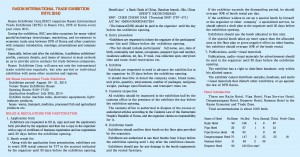
The 2014 flyer text is nearly identical to the 2013 flyer. All of the names/contacts/accounts/prices are identical. The only difference that I noticed was that two of the domestic phone numbers for the Rason Exhibition Corp. have changed. Two more remained unchanged.
Here are the event details:
4th Rason International Trade Fair
Exhibition Period: August 18-21, 2014
Venue: Rason Exhibion House
Opening Hours: 9:00-17:00
Application Deadline: July 20th, 2014
Here are posts on previous Rason International Trade Fairs: 2011, 2012, 2013.
Choson Exchange 2013 Women in Business Project
Wednesday, February 5th, 2014The innovative team at Choson Exchange have published their 2013 annual report. It is full of interesting information on the DPRK’s business sector as well as interesting information on their “Women in Business Program”.
You can read the report and a summary here.
Geoffrey See also wrote an article about the project for 38 North.
KoryoLink update
Sunday, November 18th, 2012Although KoryoLink’s corporate performance no longer appears in Orascom shareholder reports, Naguib Sawiris has given an interview in Forbes in which he offers some business details:
Sawiris has a 75% stake in Koryolink via his Orascom Telecom Media & Technology (OTMT) unit, with the remainder held by a company under the Ministry of Post & Telecommunications. He says revenues in 2012 should reach around €186 million ($145 million), with an average revenue per user of €8.6. The network only permits domestic calls and locally hosted data services. A separate cell network is available for foreigners in North Korea.
…
FORBES: How many subscribers does Koryolink have? How extensive is your coverage in DPRK?
NAGUIB SAWIRIS: Koryolink currently has more than 1.5 million subscribers. Coverage includes the capital Pyongyang in addition to 15 main cities, more than 100 small cities, and some highways and railways. Territory coverage is around 14%, and more than 90% population coverage. The subscriber base has been increasing at a very healthy rate from 950,000 at [year-end] 2011 to an estimated 1.7 million at [year-end] 2012.
FORBES: Under your joint venture with the Ministry of Telecommunications, when will Koryolink lose its exclusivity? What will happen after this period ends?
NS: Exclusivity was granted for a period of 4 years from launch. After the expiry of exclusivity in Dec. 2012, Koryolink received written confirmation that for an additional period of 3 years (until 2015) no foreign investors will be allowed in the mobile business. However, we are continuing to expand our network and services to further solidify our position [in order] to be ready for any possible competition.
FORBES: What is your role in the construction of the Ryugyong Hotel? What other real estate interests do you have in DPRK?
NS: This is a special investment that we are maintaining through our banking subsidiary in the DPRK, where Orascom has the right to operate this facility. The construction, repair and facade installations have all been completed last summer. We are planning to relocate Koryolink headquarters into the tower very soon to bring life to the building. There are no other real-estate investments in the DPRK, however, Orabank, our banking arm in DPRK, is actively working towards developing mobile-related businesses and projects.
Chris Green offers some great information (about which I have long wondered) on the process required to acquire a cell phone:
First, the individual wishing to obtain a cell phone must go to his or her local Communications Technology Management Office (통신통화관리국 or CTMO; in provincial capitals only) or a subordinate arm of the same (in smaller cities) to obtain a three page application form. This form, once filled in, must be stamped by the Ministry of Public Security officer assigned to the individual’s workplace or, for those without official workplaces, attached to his or her local people’s unit.
Having paid off the public security official in cigarettes or cash (more often the former, according to this author’s sources, because it arouses less friction) he or she must submit the stamped form to the CTMO or equivalent, whereupon it is sent, with all the speed one would expect of the North Korean transportation network, to the Ministry of Communications in Pyongyang. At this point there is little else to be done but go away and pitch the proverbial tent, because at best it takes a month for the staff in the revolutionary capital to process the application.
Assuming, and it should not be assumed, that those checks done in Pyongyang don’t yield any incriminating evidence of wrongdoing (don’t forget, the North Korean legal system makes every adult a criminal in one way or another, something which can come back and haunt any individual whenever “rents” are desired), the individual will eventually be ordered back to his local communications office, whereupon he will be handed a payment form. He or she must then take this form to a bank, and engage with the separate, and no less inefficient, bureaucracy therein in order to pay the majority (though not all) of the cost of a phone and Koryolink network activation fee.[1]
The payment form, duly stamped by a functionary at the bank, must then be taken back to the CTMO or equivalent, whereupon it can be exchanged for half the stamped application form originally sought from the ministry in Pyongyang. Here, finally, the individual reaches a watershed moment: this form can actually be exchanged for a cellular telephone!
However, the pain is actually quite a long way short of being over. In a moment of uncharacteristic efficiency, the actual cell phone shop is often directly outside the communications office, but in a moment of karma-balancing inefficiency, it doesn’t open much, carries a limited amount of product and is pitifully understaffed. As a result, queues are long, as are waits. Assuming an individual lives long enough to reach the front of such a queue, he or she is finally offered the opportunity to hand over another $70-$100 and depart the scene with a brand new phone.
Writing in the Daily NK, Kim Kwang-jin explains how people are getting around this burdensome regulatory process:
Therefore, the source said, “Middlemen in larger cities are getting multiple phones activated in random people’s names and then taking them to smaller cities to sell. Alternatively, households that don’t have any problem getting that kind of approval are mobilizing the names of their entire families to get phones, which they are then selling on to the middlemen.”
“The end users are buying these cell phones for $300 to $500 from the middlemen or from private sellers. This saves them having to go to the trouble of applying to Koryolink,” he added.
A basic Koryolink phone can be purchased officially for roughly $270- $300, excluding bribes and extraneous costs. The price of one of these semi-legal phones depends on duration of use and model. The best product, the T1, a clamshell design, is the latest and costs more than $500. The next mid-range model is the T3, another clamshell; there is also a similarly priced phone with a slide design. The budget offerings are the T95 and T107. Differences in price are mostly attributable to differences in sound quality rather than the designs, sources assert.
In addition, there are also phones available for use within individual provinces. These products, which are similar to the so-called “city phones” that were briefly permitted in the late 90s but soon got withdrawn, cost just $70 at the time of writing.
Geoffrey See of Choson Exchange also offers some insight on Ora Bank’s mobile-related business projects:
However, it appears that Naguib, Chairman of Orascom, might have other ideas. In his words, “Orabank, our banking arm in DPRK, is actively working towards developing mobile-related businesses and projects.” The 3G network provides a platform for a range of other services that emerging market economies would need including remittances and payments through mobile banking and mobile payments. Given the primitive development of the services sector, mobile provides an opportunity for Orascom to upend the services industry in North Korea.
This was something I was originally looking at in North Korea. Payments are currently messy in the country. On a previous trip, I remembered an account of a North Korean trying to pay the handphone bill. Apparently the payment went to the wrong account, and the North Koreans spent the morning calling and shouting at some people to make the mistaken beneficiary return the money so that the payment could go to the right account. For what mobile banking and payments could potentially look like in North Korea, check out M-pesa.
Read the full story here:
Pyongyang Calling For Egyptian Telecoms Tycoon Naguib Sawiris
Forbes
Simon Montlake
2012-11-18
Choson Exchange presents Rason Legal Code (2010)
Wednesday, March 14th, 2012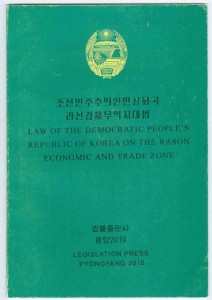
According to Choson Exchange:
In 2010, the DPRK revised the laws governing Rason Special Economic Zone.
This booklet, scanned into pdf form, sketches out the new laws in both Korean and English (English is in the back half). It was at this time that the authorities removed Rason from provincial administration, giving it more autonomy in some ways, while also giving authorities in Pyongyang a more direct link to planning for the SEZ.
Potentially interesting clauses include:
– Ships regardless of nationality are permitted to port (article 26)
– Business licenses can be revoked if DPRK law is “seriously” violated. (article 15)
– Prices will be set between the buyer and seller, though some basic consumer goods may be fixed by the local government. (article 26)
– Disputes may be resolved by arbitration either in the DPRK or a 3rd country. (article 45)
Additional information:
1. Download a PDF of the full publication here.
North Korea to announce new economic development plan and organizational restructuring
Thursday, March 1st, 2012Institute for Far Eastern Studies (IFES)
2012-2-29
North Korea is likely to make an official announcement of its new economic development plan in April to commemorate the centennial anniversary of Kim Il Sung’s birthday, which is also celebrated as a national holiday in North Korea as the “Day of the Sun.” In addition to the new economic plan, North Korea is also planning to align organizations and establish appropriate legislations in the foreign economic sector. The Daepung Group was recently consolidated with the Joint Venture and Investment Committee (JVIC).
According to an unnamed North Korean source, “many organizations in North Korea with overlapping functions or with unsatisfactory performance were merged as a part of promotion of North Korean socialism. The Daepung Group was merged as a bureau under the JVIC.”
The two chiefs of the Daepung International Investment Group (Daepung Group) were Workers’ Party of Korea (WPK) Unification Strategy Department Director Kim Yang Gun, who served as the chairman of the board, and Pak Chol Su, a Korean-Chinese businessman, who headed the group as the president and elected standing vice-chairman. They were in charge of attracting large foreign investment needed for the “10-Year State Strategic Plan for Economic Development (2011-2020).”
The WPK Director of Administration Jang Song Thaek is in charge of the Daepung Group and the JVIC and is likely to have ordered the merge of the two organizations to increase work efficiency. Kim Yang Gun’s position as the head of Daepung weakened after the souring of inter-Korean relations despite his efforts to bring investment from the South. As a result, Kim will likely step down from his position and Pak Chol Su and the executive management of the JVIC will likely manage the Daepung Group in the future.
The JVIC has also faced changes in its organization with the appointment of Ri Gwang Gun as the new head of the JVIC. Other foreign investment companies and related organizations were merged and the roles of the directors were revised.
The Beijing office of the JVIC has opened its doors in December 30 last year. North Korea is likely to dispatch experts and professionals from various organizations to provide “one-stop service” to attract more investment to North Korea, starting from this April.
Kim Chol Jin is the person in charge of the JVIC Beijing Office. The Rason Special Economic Zone (SEZ) and Hwanggumpyong SEZ will have a change in leadership, as Hong Suk Hyong will replace Kim Il Young as the new vice-chairman.
The previous chairman of the JVIC, Ri Su Yong, who was also the former ambassador of the DPRK to Switzerland, is now serving as the new advisor to Kim Jong Un at the Secretary’s Office.
*Addendum: Choson Exchange has been talking about this for a couple of months. See posts here (2012-3-4), here (2010-2-13) and here (2012-1-10).
Choson Exchange with a JVIC update
Monday, February 13th, 2012According to Choson Exchange:
As we mentioned recently, Ri Chol, the broker of the Orascom deal, has moved on from JVIC. Where he has gone is not yet certain, but the choice for his replacement is interesting.
Ri Gwang Gun is the new head of JVIC and was introduced as such to the CEO of Orascom last week. Ri Gwang Gun has held various positions related to trade, including executive positions at state owned enterprises and as Minister of Foreign Trade. He apparently reports to Kim Yang Gon.
He was (is?) a Daepung Investment Group man. We’ve speculated that the existence of both Daepung and JVIC reflected a kind of “competition at the top” for influence in attracting and managing investments. They were both formed around the same time in 2009/2010 and have similar charges. Therefore, Ri Gwang Gun’s promotion could indicate a potential harmonizing of this competition.
Of course, the contours of this are difficult to see. Daepung, with stronger ties to the NDC, could be construed as taking over the JVIC from the top; perhaps the military has been able to exert itself to make sure that in the new leadership era, it does not get shut out of the investment game. (JVIC has become the more active and influential of the two groups.)
It could also be seen as a victory for JVIC, with Daepung being left to crumble and the top talent from that group being brought across. It remains to be seen if there will be some kind of exodus from either group.
Perhaps, also, it is some kind of compromise and a merger of sorts, with competing groups of elites ‘buying in’ to a unified system of investment management under the JVIC brand. They may see this as a way to increase effectiveness, avoid the negative outcomes of unfettered intra-elite competition and therefore encourage stability overall.
Abrahamian with a CNC update
Wednesday, February 8th, 2012Pictured above: the DPRK’s two CNC plants mentioned in the post below. (L) Ryonha Factory in Pyongyang, (R) Ryonha Factory in Huichon
From the Choson Exchange web page:
The company that is tasked with producing and selling CNC is Ryonha, through its subsidiary, Unsan. The company had a booth at the recent International Trade Fair in Rason, held in North Korea’s Special Economic Zone in the far Northeast, bordering Russia and China. Their booth was staffed by a Vice President and – as one might expect – attracted lots of attention from the locals in attendance.
The president claimed annual exports of 30,000,000 euros to Europe, South America and South East Asia. He didn’t have exact details on profits, but mentioned that Unsan imported 10,000,000 euro worth of parts, mostly from Europe, such as control units and electronic relays Siemens and Arno. Their main CNC factory is 40,000 sq. meters and the “biggest in the world” according to the manager. They have two facilities, one in Pyongyang and one in Jagang with 12,000 employees in total. They want to open a factory in Rason, ideally without investors. Prices were said to be: 150,000 EUR for a European made CNC machine but only 52,000 EUR for an equivalent machine made in the DPRK, with the “same quality”.
Unfortunately for Ryonha, it seems to be a subsidiary of the Korea Ryonbong General Corporation, which is under UN sanctions as a WMD proliferator. This no doubt impacts Ryonha’s ability to market itself to customers abroad. Ryonha also doesn’t seem to have a website, which can’t help, either.
Should Ryonha’s parent corporation be taken off the UN’s list of designated proliferators, it will find easier access to a global CNC market that was $6.1 billion in 2007, before the financial crisis hit. The market has contracted since then, as the crisis left a global glut in inventory in 2009, which has taken well into 2011 to clear. The sharply reduced demand, particularly from automakers, has made the CNC market particularly competitive, though a sustained economic recovery would eventually drag the industry back up to pre-crisis levels.
It’s difficult to know what kind of impact Ryonha might have on the global CNC industry, as customers and vendors alike are probably reluctant to trumpet where their machines are made. One of the effects of sanctions has been that companies try to hide their tracks when conducting business with the DPRK, even when the industry is unrelated to sanctioned items. This is sometimes done through an extra layer (or two) of outsourced contracts, or with textiles, sometimes just label-switching. This is tough to do with bigger machines, of course, leaving North Korean CNC machines facing perhaps understandable prejudices.
Its impact on the domestic market will be more significant, of course, reducing the need to spend hard currency on imported CNC machines from China and elsewhere. Perhaps then, this import substitution will allow the DPRK to use that unspent capital on projects that actually benefit the daily lives of its citizens.
Ri Chol out as JVIC chief
Tuesday, January 10th, 2012According to Choson Exchange:
[The] Choson Ilbo has just reported that Ri Chol has left his post as head of the Joint Venture and Investment Committee (JVIC).
As we argued last fall, the name of the game for Pyongyang’s elites is securing trade and investment deals. Two main investment organs exist, the JVIC and the Daepung Investment Group. We have in the past heard rumors of other similar international investment organizations being under consideration, also. From these overarching groups, down to smaller State Owned Enterprises, there is considerable competition to show that one’s organization can deliver.
Ri Chol was a close ally of Kim Jong Il’s and the organization he came to be associated with, JVIC, rose to prominence after he helped put together the Orascom deal and was given stewardship. He was even with Kim on his last official visit, to a joint venture supermarket in Pyongyang.
He also spent most of the 1980’s and 1990’s in Switzerland in various diplomatic capacities, not the least of which was acting as a minder to Kim Jong Il’s children as they studied at private school.
What might his departure portend?
A few possibilities come to mind.
– Has the JVIC fallen out of favor with the new leadership? If this is the case, Ri might be tasked with building a new organization, perhaps with a similar focus. It would seem redundant to add another, rather than reform this one, but redundancy is hardly unheard of in planned economies.
– Has Ri himself fallen out of favor? Is he being put out to pasture? Again, it is impossible to know, but it seems that such a long term friend of the Kims, who has a personal relationship with Kim Jong Un from his school days would be a key ally at this time, especially since his deals are driving economic growth in North Korea. (Though who knows? Perhaps Kim the Younger has never liked him.)
– If not an issue with Ri personally, the move could be a part of a factional reshuffling. Bartering and dealmaking for control of the commanding heights of the economy is no doubt underway as the new government consolidates its power. It might have been deemed necessary to grant control of the JVIC to another group of Pyongyang movers and shakers – of which Ri Chol is not a part.
– Also very possible is that the very top leadership is planning to give Ri some new responsibility elsewhere. JVIC may have been judged to be running smoothly enough that Ri’s skills would be more effectively used another important organization.
This of course is highly speculative. All we really know is that Ri Chol, with a track record of securing investment, has left the JVIC. Whatever the case may be, he is worth watching in the coming months, as Pyongyang is compelled to keep investments from China and elsewhere coming.
You can read a longer bio on NK Leadership Watch.

